Report

Note to readers
Welcome to the sixth annual report on the global diamond jewelry prepared by the Antwerp World Diamond Centre (AWDC) and Bain & Company. This year’s edition covers industry developments in 2015 and early 2016 and takes a close look at the millennial generation (roughly speaking, people born between 1980 and the early 2000s) as a new category of diamond buyers. We begin with key developments along the value chain. In subsequent sections, we review factors that influenced rough-diamond production and sales, midstream performance and global diamond jewelry demand in major markets.
We then share diamond jewelry consumer insights from our proprietary research across China, India and the US, highlighting the attitudes and behaviors of millennials. We also provide an update on the long-term outlook for the diamond industry through 2030. The 2030 supply-demand forecast considers recent changes in mining operations and expected global macroeconomic effects.
Readers looking for a brief overview of the key takeaways from this report can find them below:
- Following a period of growth from 2012 through 2014, diamond jewelry consumption has entered a moderation phase. In 2015, retail sales of diamond jewelry grew 3% at constant exchange rates but declined about 2% in US dollar terms. The US remained the sales growth engine of the global diamond jewelry market, as the same-store revenues of mainstream US jewelry retailers improved, reflecting strong middle-class consumption. Greater China is still rebalancing as slowing tourist flows to Hong Kong and Macao offset otherwise positive dynamics in mainland China. Europe and Japan in 2015 benefited from the shift of spending by Chinese consumers from Hong Kong and Macao. This shift was reflected in positive consumption growth in euro and yen terms. Strong macro-demographic trends powered positive consumption dynamics in India. The strong US dollar nonetheless pushed growth in those markets into negative territory in dollar terms.
- Midstream US dollar revenues tracked the retail sector’s performance in 2015, declining 2%. Slowing demand and a drop in polished prices resulted in some of the lowest profit margins in years, as well as high inventory levels, accumulated since 2013. As the year came to a close, cutters and polishers significantly reduced rough-diamond purchases and off-loaded about $5 billion of inventories to improve cash flows.
- Major rough-diamond producers in 2015 reacted to the challenging circumstances of their customers by reducing output, increasing their own inventory levels and providing more flexible purchasing terms while cutting rough-diamond prices. As a result, rough-diamond sales fell 24% in 2015.
- The industry is rebounding in 2016. Restocking by midstream players, following their inventory sell-off in late 2015, produced growth of around 20% in rough-diamond sales during the first half of 2016. However, strong rough-diamond sales in 2016 may again lead to swollen midstream inventories if retail demand does not strengthen proportionately. Declining sales at major jewelry retailers in the first half of 2016 indicate a possible demand slowdown in the US and China. The final growth trajectory for 2016 and the strength of midstream and rough-diamond sales in the beginning of 2017 will be determined by the performance of the diamond jewelry retail segment during the year-end holiday season.
- A new generation of consumers—the millennials—represents a compelling opportunity for the diamond industry. The population of millennials in China, India and the US totaled roughly 900 million in 2015, and their combined gross income amounted to approximately $8 trillion. Millennials appear to resemble other age groups in their preferences for diamond jewelry but not in their shopping behaviors. To fully capture millennials’ demand over the longer term, industry players need to invest in both category marketing and brand-building efforts and redefine the customer experience in the retail environment.
- The key challenges facing the diamond industry remain the same as in previous years. The midstream sector still needs to secure access to financing and continue to improve its business model to sustain profitability amid potential price volatility. Over the longer term, consumption may continue to slow in China, and there is a risk of a cyclical recession in the US. Synthetic diamonds as an emerging competing category to diamonds remain a risk, but diamond industry participants are determined to reduce the threat from synthetics by marketing the emotional attributes of natural stones. The recently formed Diamond Producers Association (DPA) is reviving industry-wide generic marketing efforts.
- The long-term outlook for the diamond market remains positive. For the next three years, the supply of rough diamonds is expected to maintain a tight balance with demand. We expect demand for rough diamonds to recover from the recent downturn and return to a long-term growth trajectory of about 2% to 5% per year on average, relying on strong fundamentals in the US and the continued growth of the middle class in China and India. The supply of rough diamonds is expected to decline annually by 1% to 2% in value terms through 2030.
1. Recent developments in the diamond industry
- The year 2015 was a challenging one for the diamond industry. A decline in consumer demand for diamond jewelry that started in 2014 in Greater China had a ripple effect throughout the diamond industry that lasted into 2015. Weaker-than-expected consumer demand affected polished-diamond sales as retailers reduced purchases of polished diamonds. The slowdown extended to midstream companies as they built up inventories and reduced purchases of rough diamonds.
- Rough-diamond revenues declined by 24% in 2015 as the midstream segment sold down accumulated inventories. Manufacturers reacted to softening demand by reducing production, increasing inventories and cutting rough-diamond prices. ALROSA, which increased production in 2015 by 6%, saw its inventory levels rise when rough-diamond sales fell in the second half of 2015. De Beers curtailed production by 12% throughout 2015. Rough-diamond prices fell by 15% in late 2015 and remained largely static in 2016’s first half.
- Cutting and polishing revenues declined by 2% in 2015. Slowing demand forced midstream players to reduce rough-diamond purchases and unload inventory accumulated in 2013 and 2014. Polished-diamond prices declined by 10% in 2015, and the operating margins of many cutting and polishing manufacturers were at or below breakeven. Midstream players report margin improvements in 2016 due to reduced rough and polished diamond prices.
- Global diamond jewelry demand grew 3% in local currencies in 2015 but declined 2% in US dollar terms. Sluggish demand in China offset positive trends in the US. Currency depreciation drove revenue declines in Europe, India and Japan despite sales growth in local currency terms. The industry is stepping up its marketing efforts in generic and targeted programs to boost consumer demand for diamond jewelry.
- The diamond industry in 2016 is on the road to a recovery. Rough-diamond suppliers posted strong sales in the first half of 2016, mostly due to restocking by cutters and polishers following their inventory sell-off at the end of 2015. Despite the positive indicators, the 2016 outlook for global diamond jewelry demand remains uncertain, with retailers reporting minimal sales growth in key markets.
- The medium-term outlook remains challenging, as new supply is expected to come online and uncertainties cloud the social, political and economic environments in key markets. In the long run, the positive macroeconomic outlook is expected to work in the industry’s favor—as long as diamond producers behave responsibly and industry players sustain marketing efforts to support diamond jewelry demand, especially among millennials.
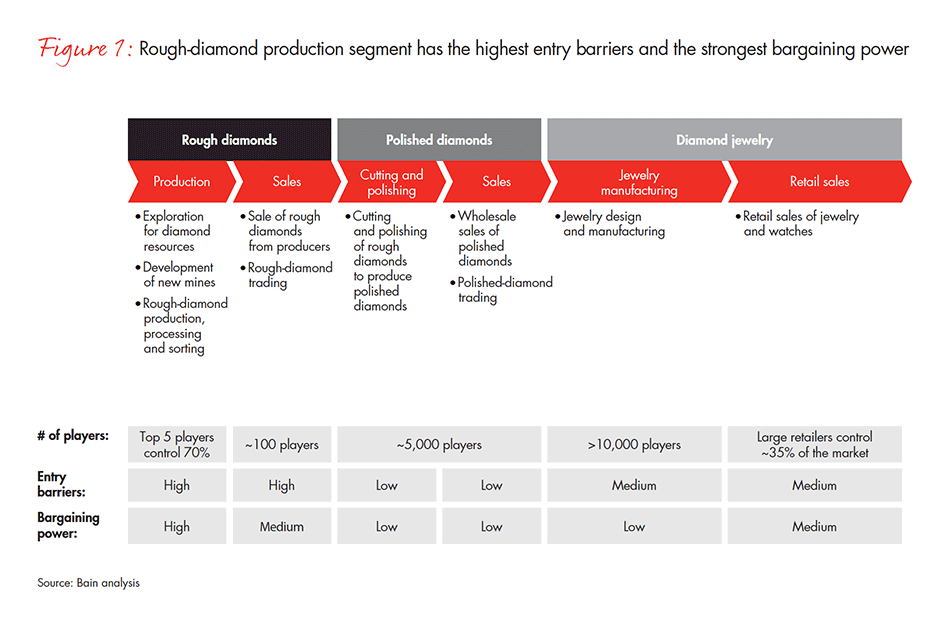
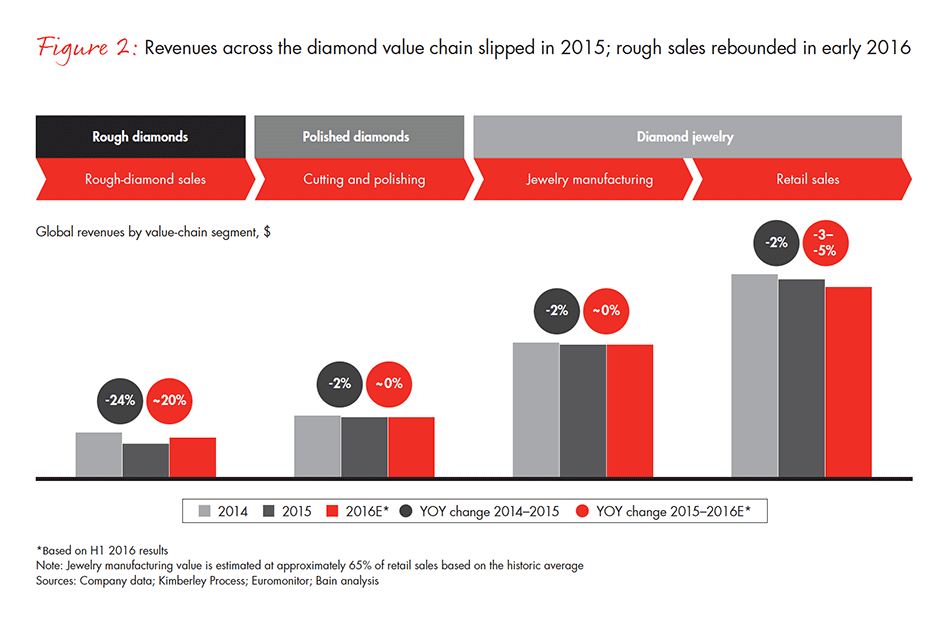
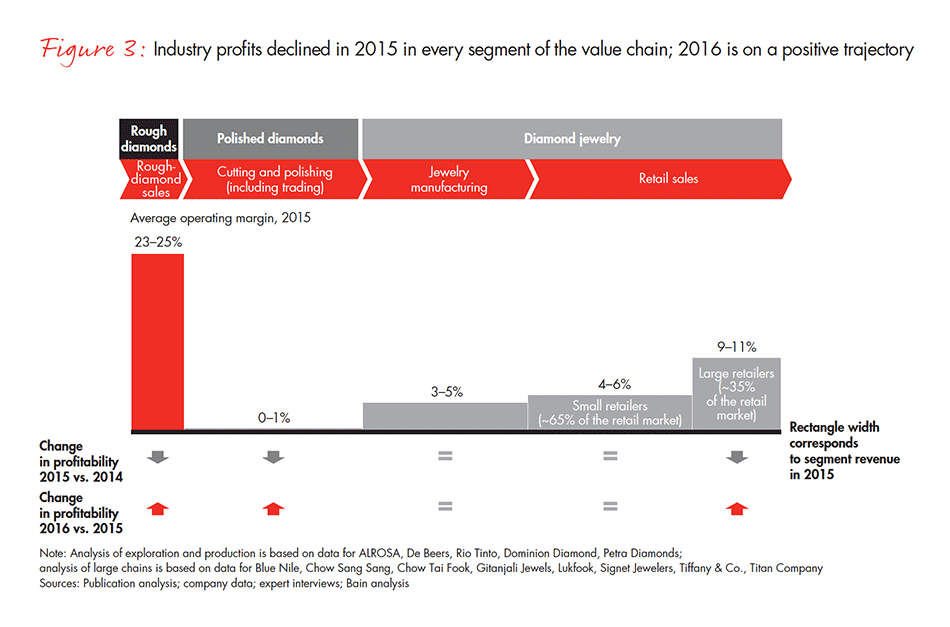
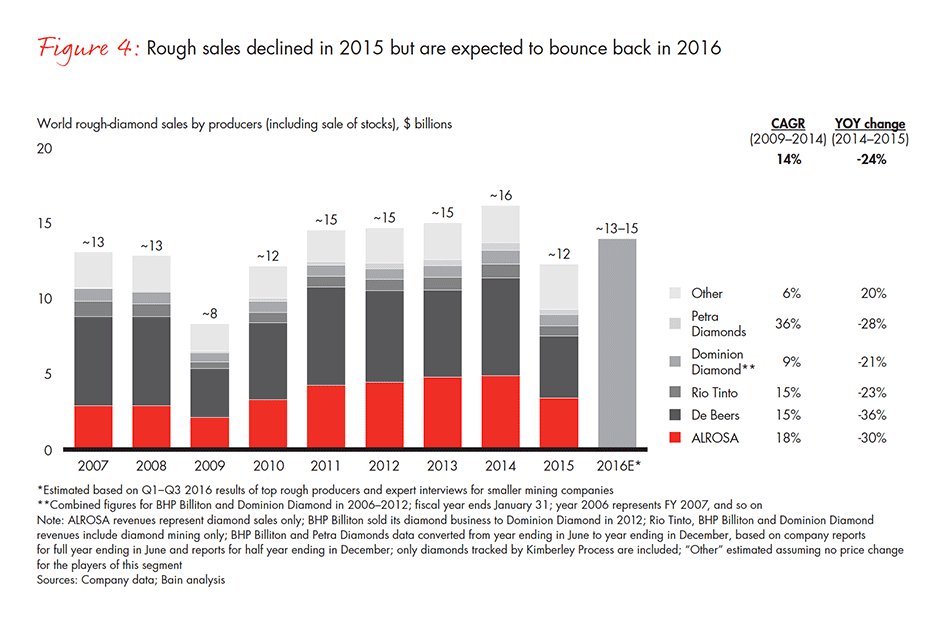
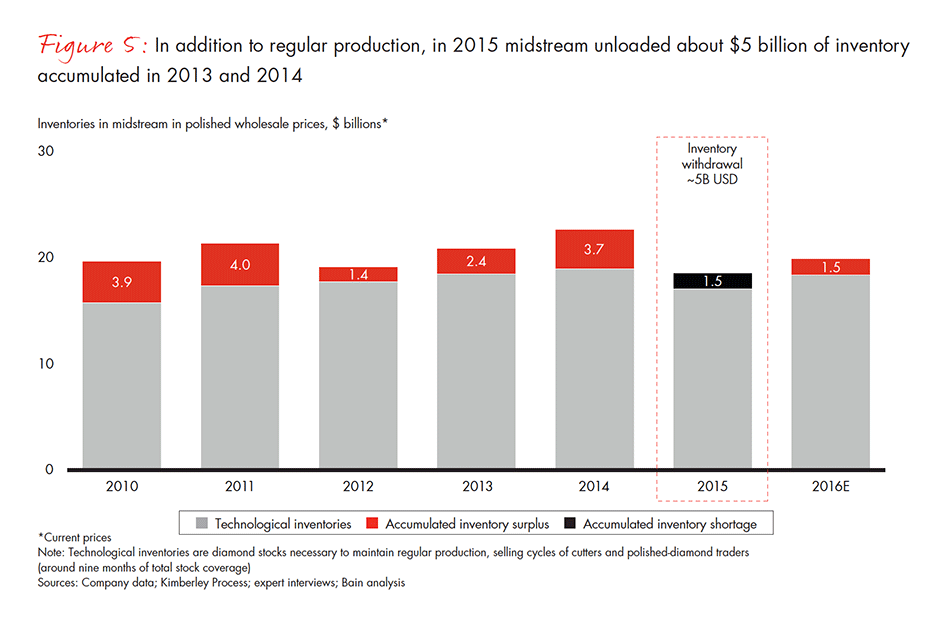
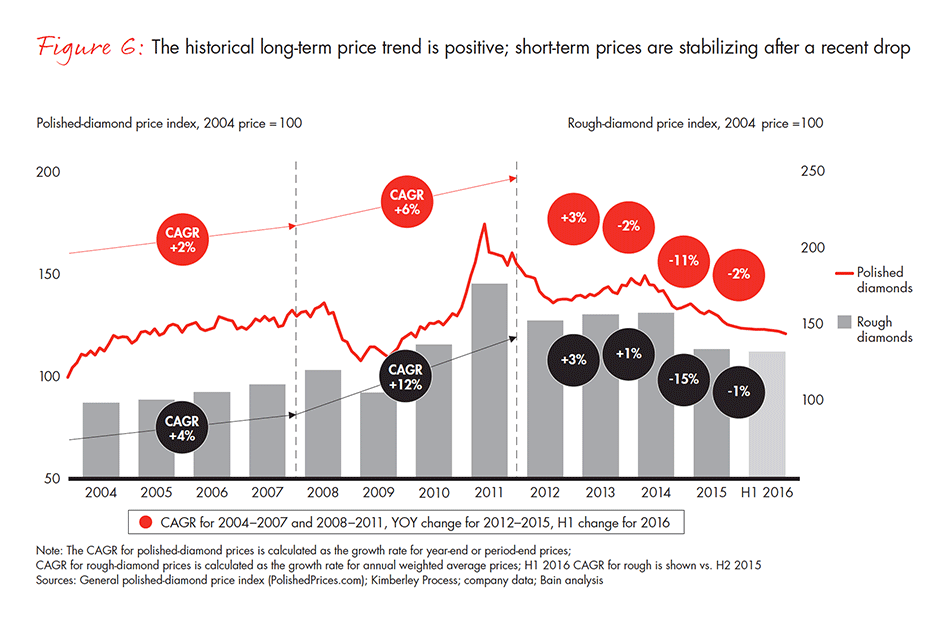
2. Rough-diamond production
- Continuing the trend from the past eight years, global rough-diamond production volume remained relatively stable, increasing by 2% in 2015 to 127 million carats. The largest production increases occurred in Australia and Russia as Rio Tinto’s Argyle mine increased output, ALROSA moderately increased production, in line with previously announced plans, and the Grib mine accounted for new supply. The largest drop occurred in Africa, as De Beers cut mining output in Botswana several times throughout the year in response to changing market dynamics.
- Rough-diamond sales declined 24% in 2015 as midstream players reacted to sluggish demand for polished stones and high prices for rough diamonds by cutting orders and selling down their inventories in the second half of 2015. The combined market share of ALROSA and De Beers fell from about 70% in 2014 to about 60% in 2015 due to considered efforts to decrease supply. Smaller players held production steady and increased their shares.
- After a decline of about 15% in late 2015, rough prices remained at the same lower level throughout most of 2016. Although both ALROSA and De Beers have reduced production, global year-over-year sales for rough diamonds have grown more than 20% in 2016 because of increased sales volumes—including accumulated inventories. The revenue outlook for full-year 2016 is very positive, based on strong sales by major producers at recent Sights in preparation for the holiday season.
- Operating margins were mixed in 2015. ALROSA posted the largest improvement in 2015 earnings before interest and taxes (EBIT) margin, from 36% to 43%, on the back of a devalued Russian currency. In the first half of 2016, ALROSA, De Beers and Petra Diamonds posted improved EBIT margins, while other manufacturers reported margin declines.
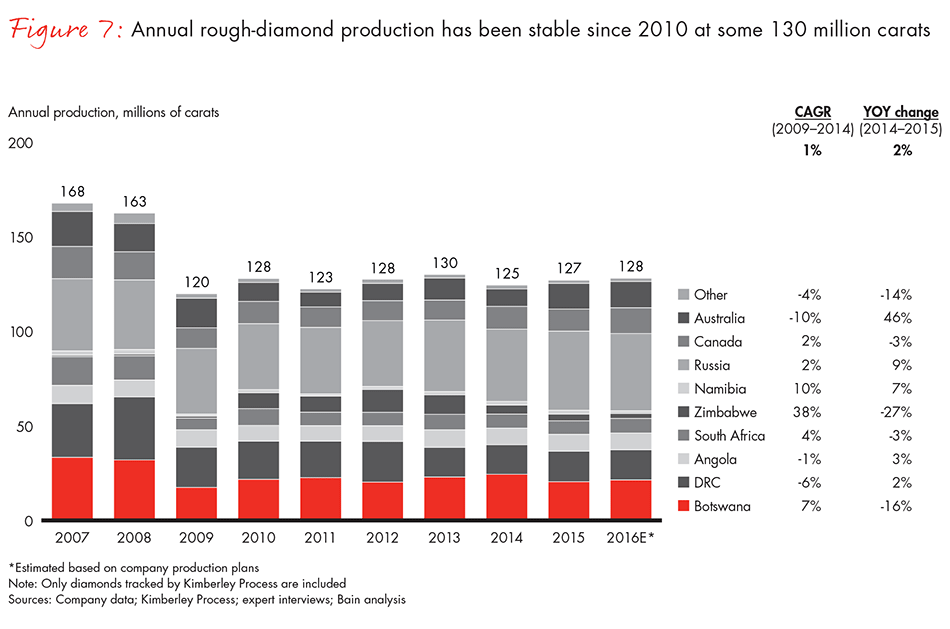
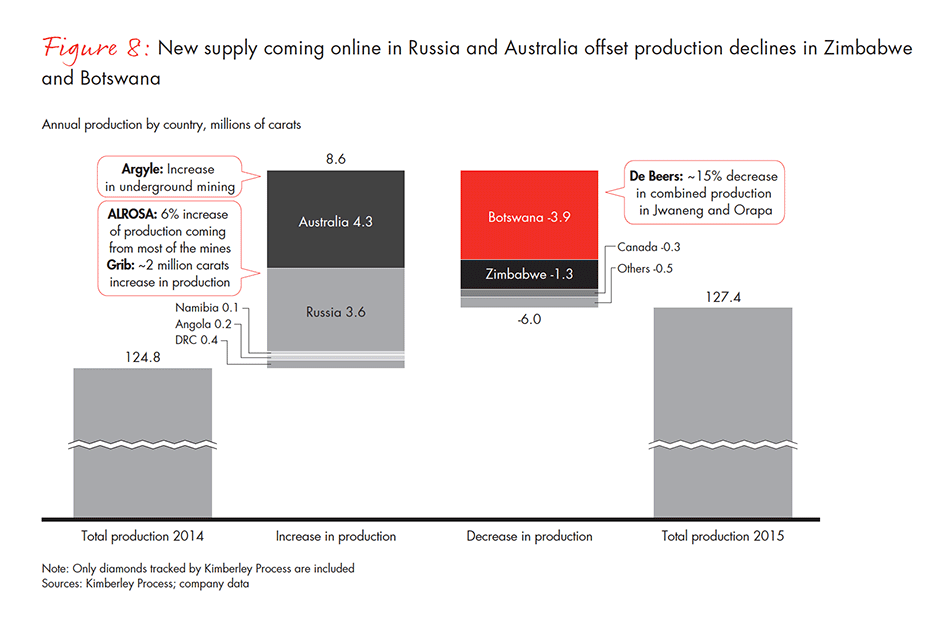
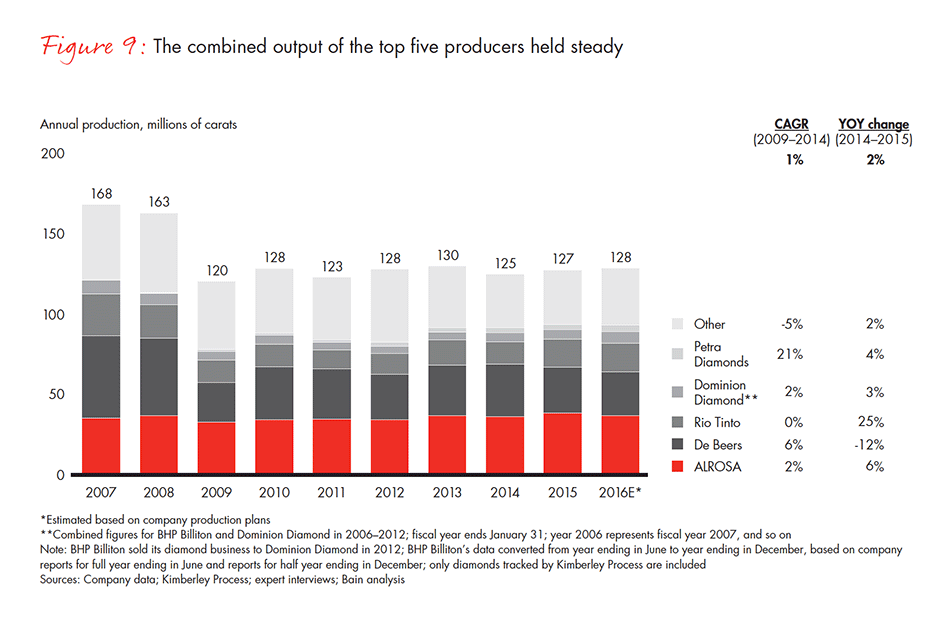
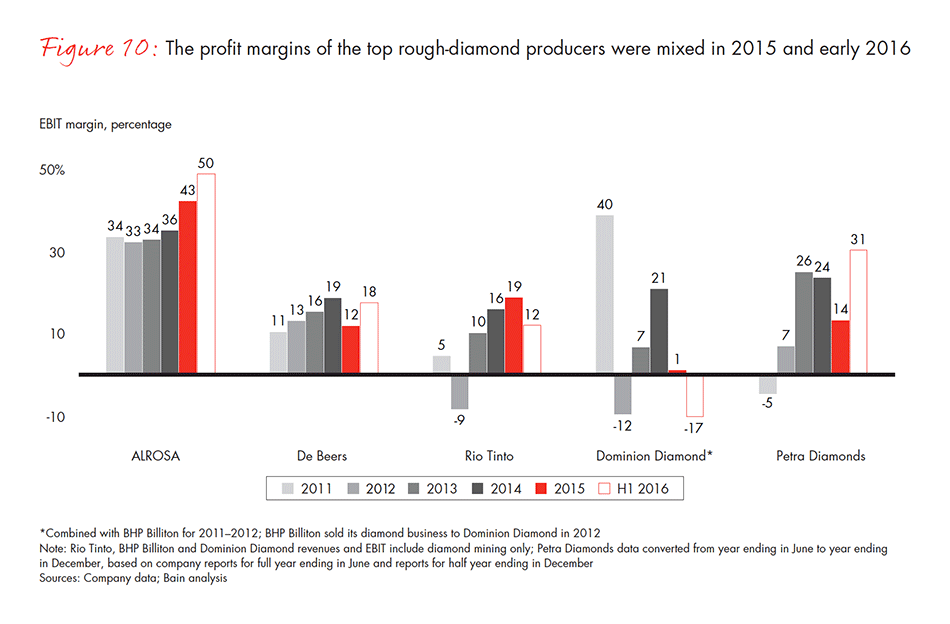
3. Cutting and polishing
- Revenues in the cutting and polishing segment declined by about 2% in 2015 because the slowdown in global diamond jewelry demand increased retailers’ inventories. The combined midstream market share of India and China grew to roughly 90% due to their midstream segments’ low cost structures.
- The slowdown in diamond jewelry demand tightened midstream players’ margins to near breakeven levels and swelled excess inventories in their pipelines. In addition to regular production, in late 2015 midstream unloaded about $5 billion of inventory accumulated in 2013 and 2014 into downstream markets. Combined with the demand slowdown, the move contributed to a decline in polished-stone prices of about 10% in 2015.
- The first half of 2016 began with strong gains in rough-diamond sales as midstream players tapped their underused credit lines to restore inventories to their historical operating levels. Lower rough-diamond prices should translate to margin improvements in 2016. The final results for 2016 and early 2017 will depend largely on manufacturers’ ability to carefully balance inventory levels against year-end demand.
- In the short to medium term, the cutting and polishing segment will likely continue to work at tight profit margins, because the segment is highly sensitive to pricing volatility and the supply-demand balance of rough and polished diamonds. Moreover, players can exert only limited leverage over suppliers and retailers. In the long run, data-driven inventory management, more flexible sales terms from rough-diamond producers and major traders, and improved compliance with bank reporting policies by midstream manufacturers may help improve the segment’s risk profile and sustainable profitability.
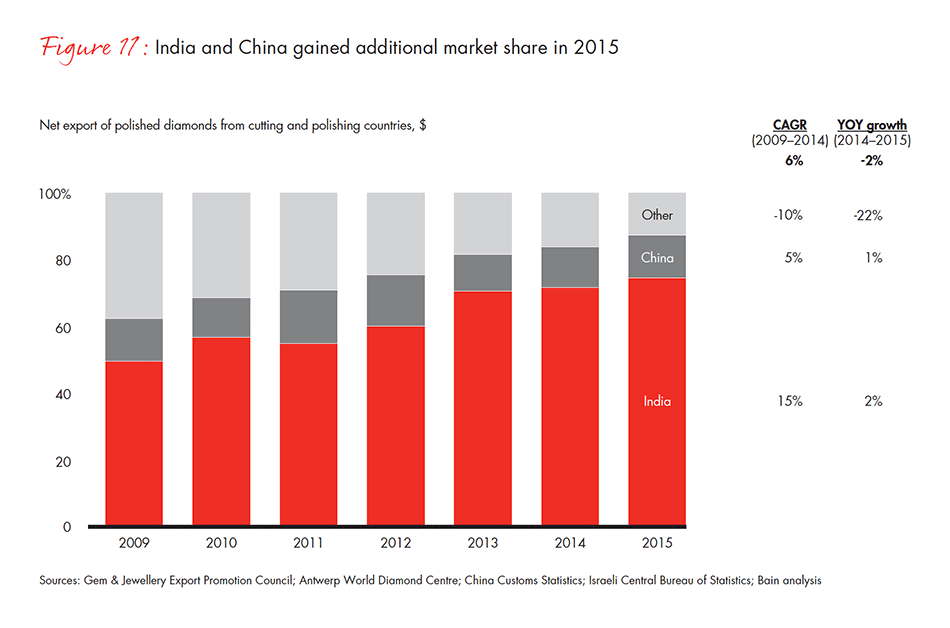
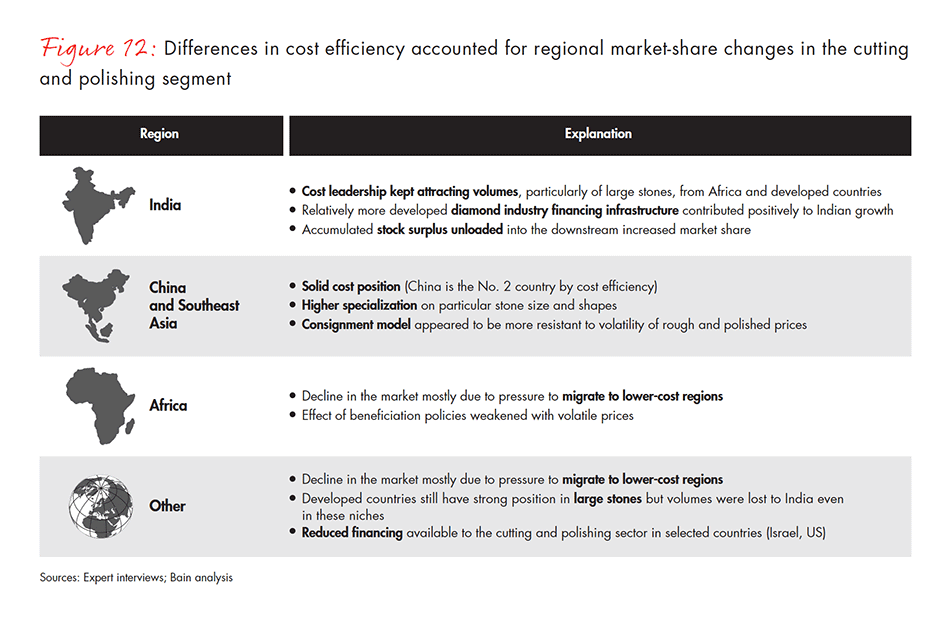
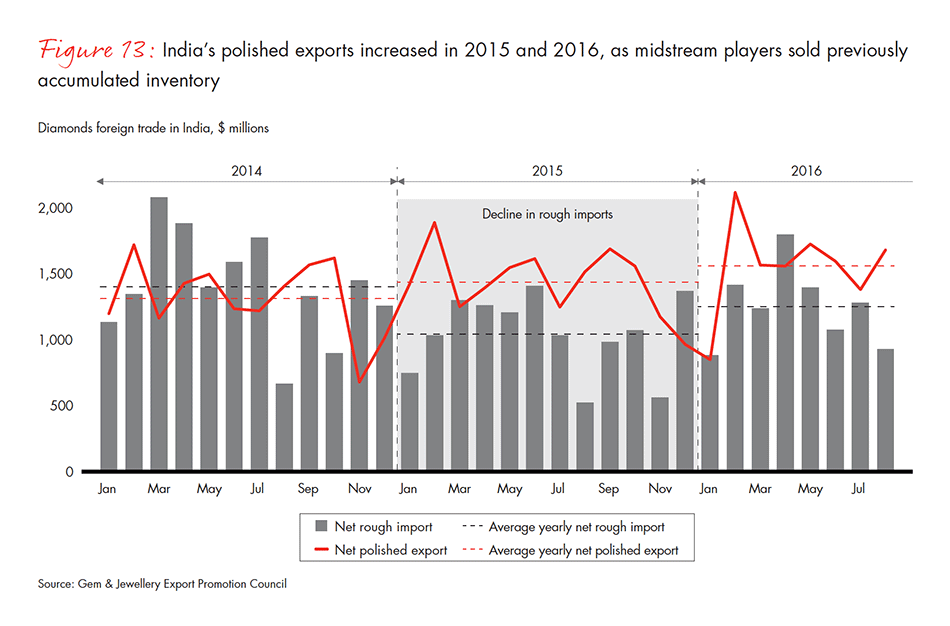
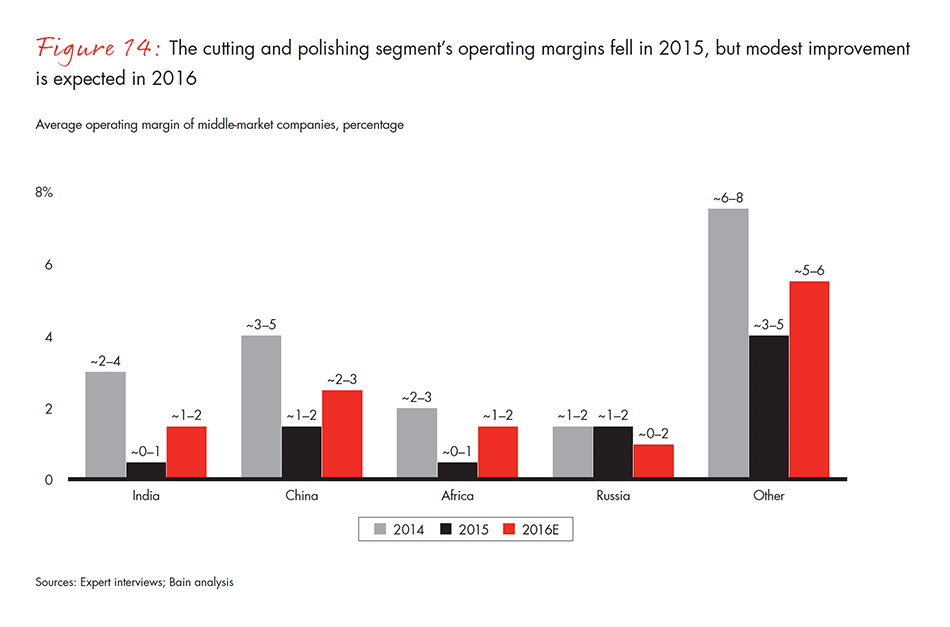
4. Diamond jewelry retail
- Global diamond jewelry retail sales in 2015 increased about 3% at constant exchange rates, in line with positive trends in the global personal luxury goods market. Currency depreciation in 2015 contributed to a decline in global revenue of about 2% in US dollar terms.
- Strong demand by middle-class buyers spurred growth in the mainstream jewelry retail segment and was the main contributor to an increase in US diamond jewelry sales. High-end jewelry retailers did not see similar growth in demand from more affluent buyers.
- China’s diamond jewelry sales in 2015 dropped slightly at constant exchange rates because of significant market contraction in Hong Kong and Macao. Diamond jewelry growth in mainland China remained positive, with major retailers—both brick-and-mortar and online—posting same-store sales growth. At the same time, the yuan’s rise against the euro and the yen, stricter travel requirements and tighter control over gambling redirected Chinese tourists’ spend away from Hong Kong and Macao to other international destinations.
- Europe, India and Japan delivered revenue gains, measured in local currencies, in 2015. The weaker euro and yen lured tourists to Europe and Japan, and growth in the middle class and disposable incomes supported market gains in India. However, the devaluation of national currencies against the US dollar in 2015 pushed dollar-denominated revenues into negative territory.
- Overall global diamond jewelry sales are expected to decline slightly in 2016.
- In the first half of 2016, major US jewelry retail chains posted flat to negative sales growth. The culprits were an economic slowdown in energy-producing states and a temporary reduction in overall consumer spending, as baby boomers begin to move beyond their peak spending years before millennials reach theirs.
- The search for a new set point in the Chinese diamond jewelry market, which started in 2014–2015, continues in 2016. Growth in the Chinese market will likely contract, with weakening fundamentals in mainland China compounded by continuing declines in Hong Kong and Macao.
- Market growth in Europe and Japan is expected to slow in 2016, in local currency terms, as the euro and yen strengthen, leading to a decline in inbound international spending. In India, new government anti–tax evasion initiatives could offset positive macroeconomic trends, while further rupee devaluation is likely to offset demand growth in local currency terms.
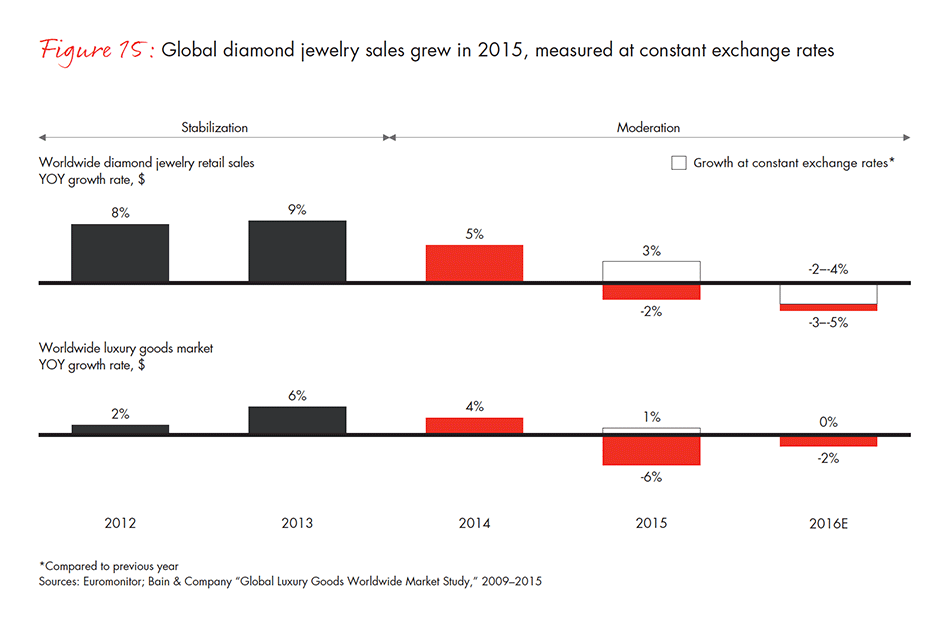
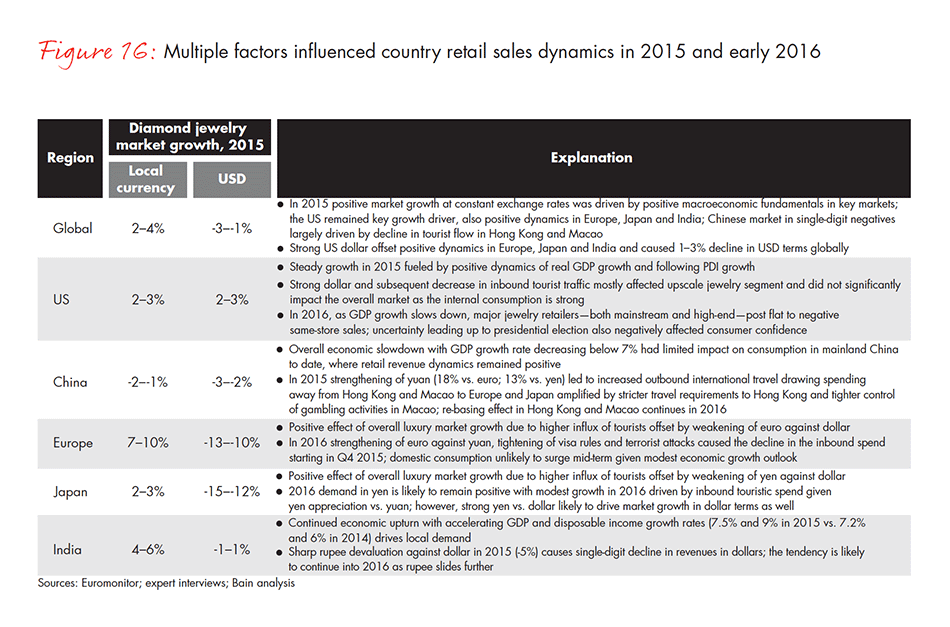
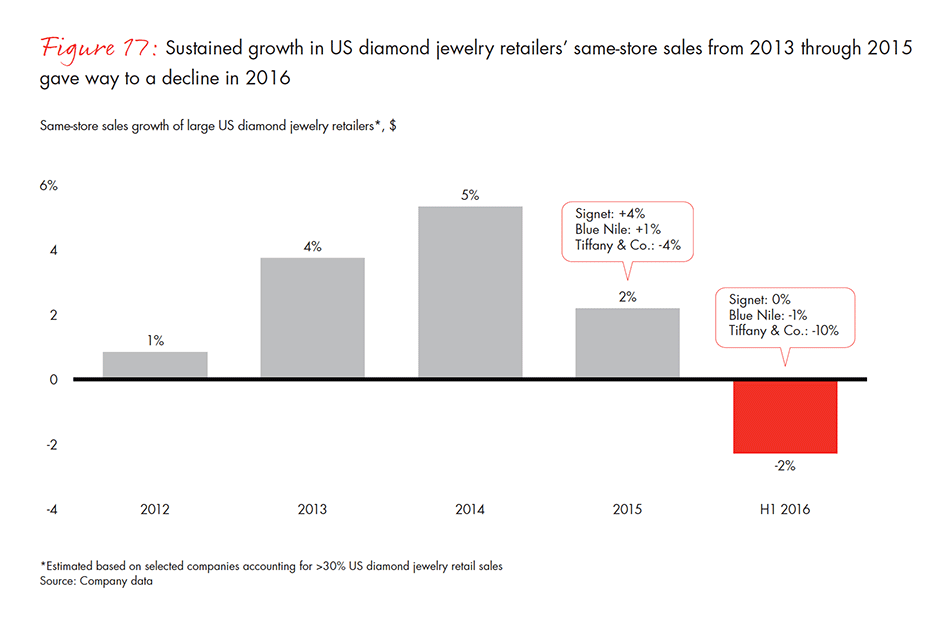
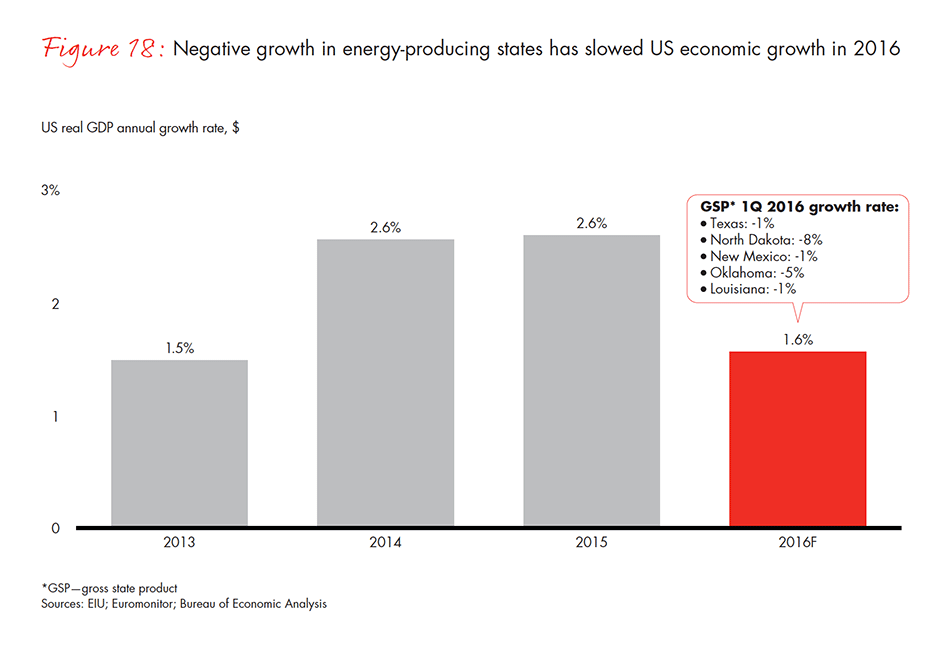
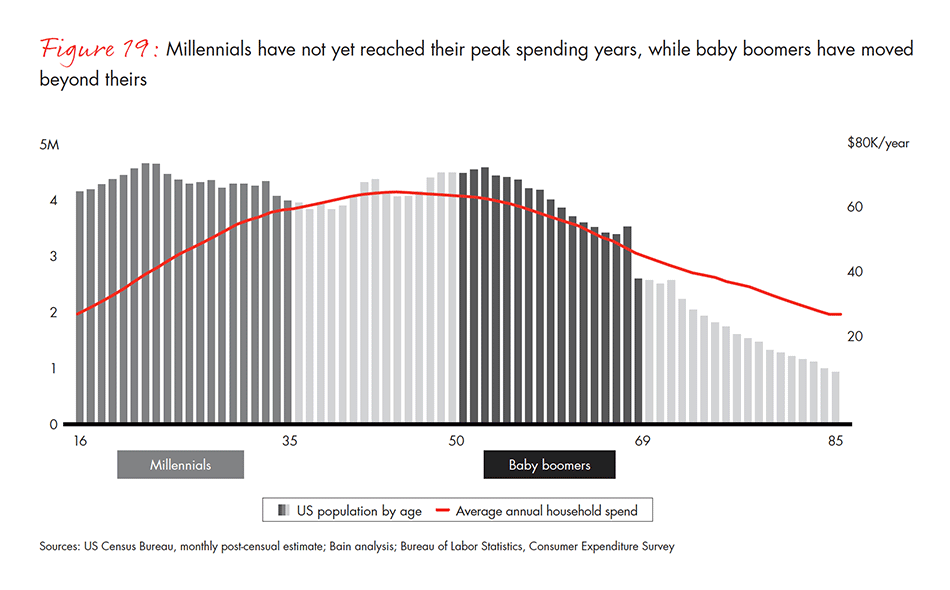
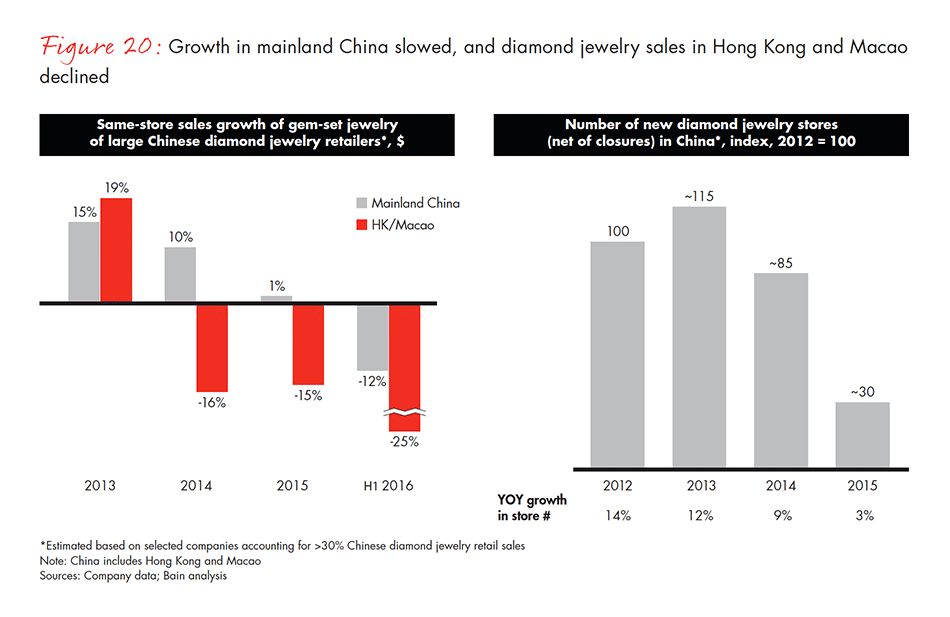
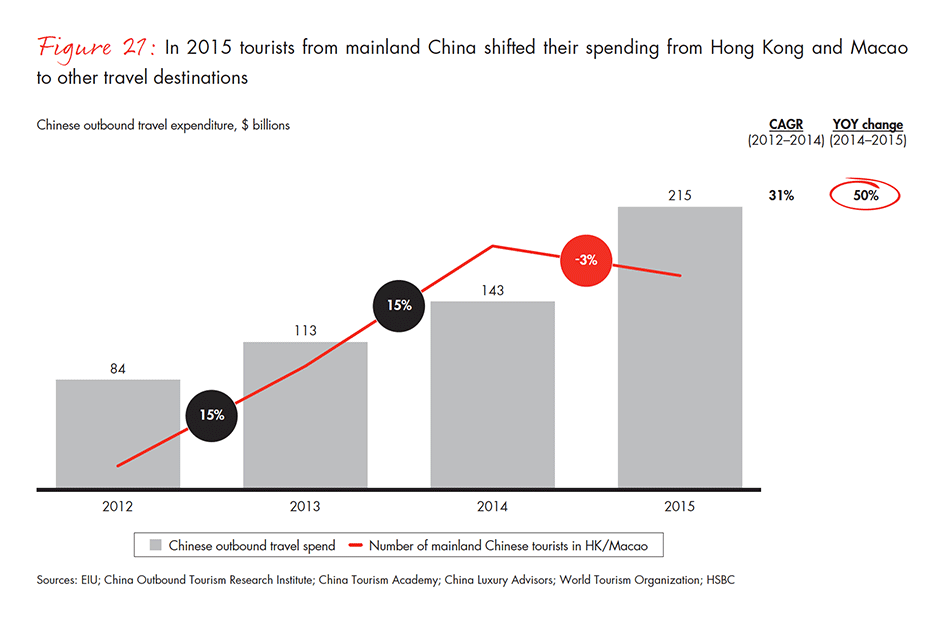
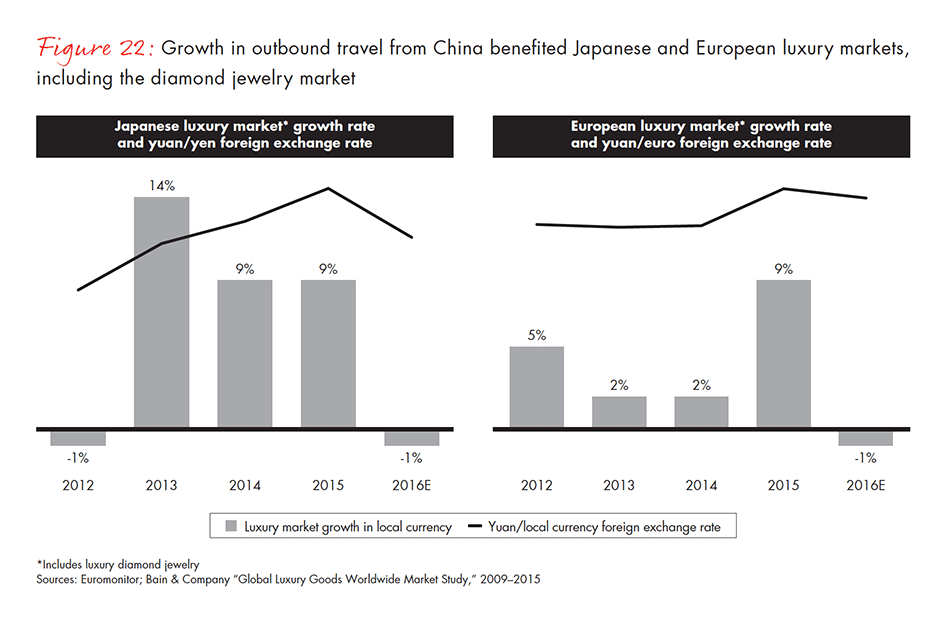
5. Diamonds: The view from the millennial generation
- For this year’s report we conducted a survey of diamond-related consumer preferences, with a specific focus on millennials in China, India and the US.
- Jewelry remains one of the top three preferences among all consumers when it comes to giving or receiving gifts, ranking third in the US and first in China and India.
- Millennials represent a significant opportunity for the diamond industry. The age group is similar to previous generations in terms of size, current and future spending levels and positive attitudes toward diamond jewelry. However, differences in shopping behavior suggest that dedicated marketing efforts and targeted customer acquisition strategies are needed to reach this group of customers effectively.
- The population of millennials in China, India and the US totaled roughly 900 million in 2015, or 27% to 35% of the three countries’ total population. The millennials’ combined gross income amounted to approximately $8 trillion, which, if they were a nation, would make them the world’s fourth-largest economy, behind the US, the EU and China. Millennials’ combined gross income will likely double to some $16 trillion, or 38% of total gross income, by 2030.
- Millennials in China and India rank jewelry as their No. 1 gifting category; non-millennials ranked it second. US millennials place jewelry as their No. 3 choice, after money and electronics.
- Millennials tend to spend as much of their incomes on jewelry as other age groups. Millennials in the US are more active than millennials elsewhere in their use of the internet for jewelry purchases; in India, millennials tend to prefer department stores. In both India and the US, millennials are likely to seek family advice before buying. Chinese millennials, like other age cohorts in China, prefer to shop at specialized jewelry retailers and tend to make their purchase decisions in-store.
- Millennials in China and the US who are considering synthetics as an alternative to diamonds cite synthetics’ lower prices as their key decision driver. Millennials in India cite their perception of a more favorable ratio of price to quality. In China and India, millennials cite the advanced technology that goes into synthetics production as their No. 2 decision driver. When asked about the feelings that synthetic diamonds evoke, millennials report several negative associations, such as “fake,” “not real” and “cheap,” as well as neutral ones such as “less expensive,” “technology” and “affordable.”
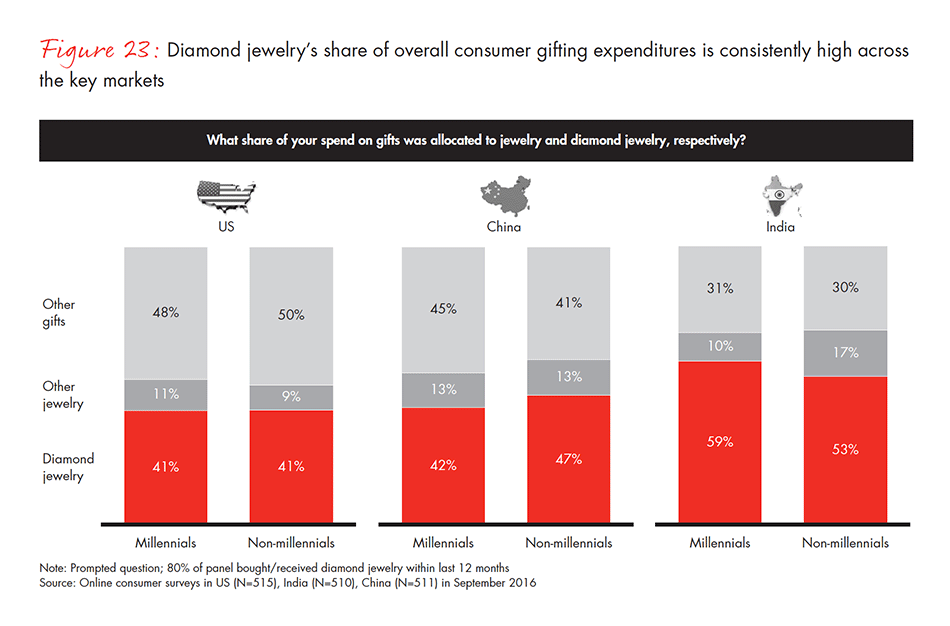
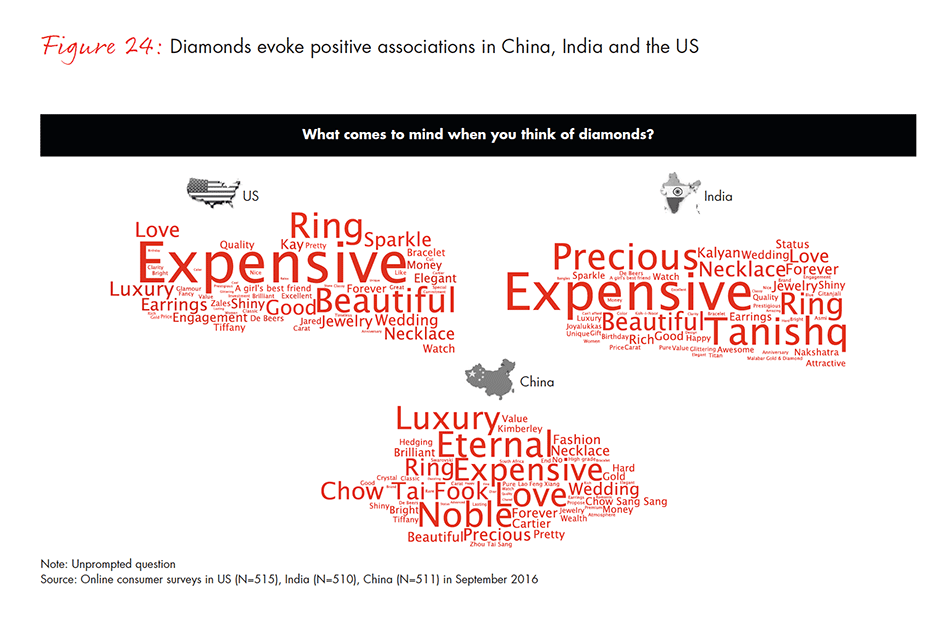
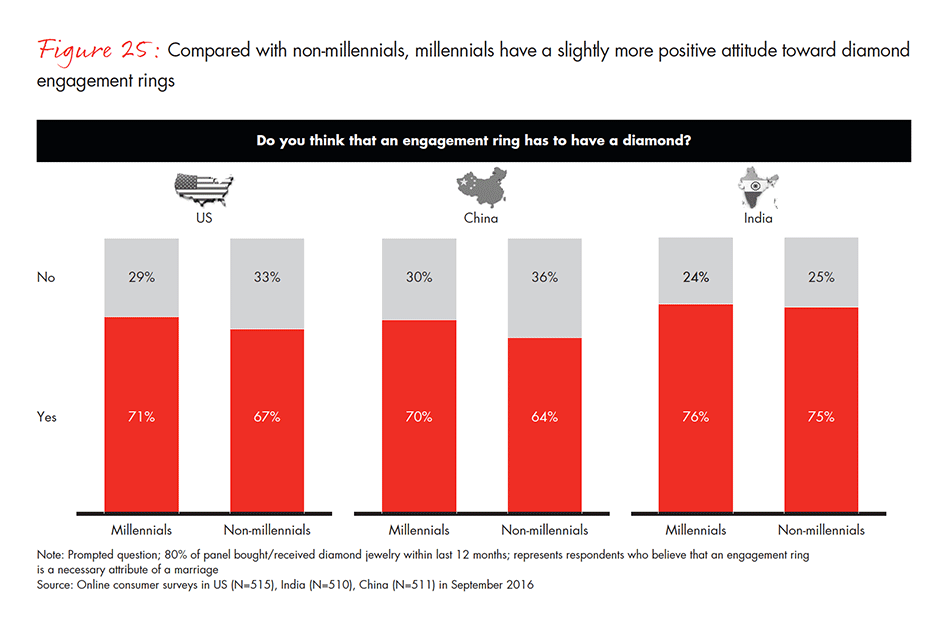
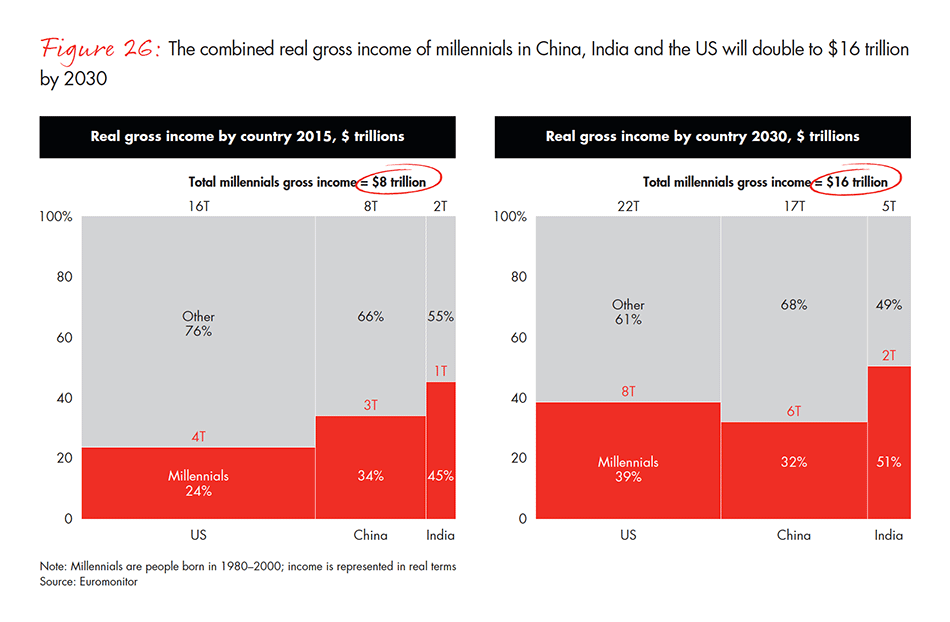
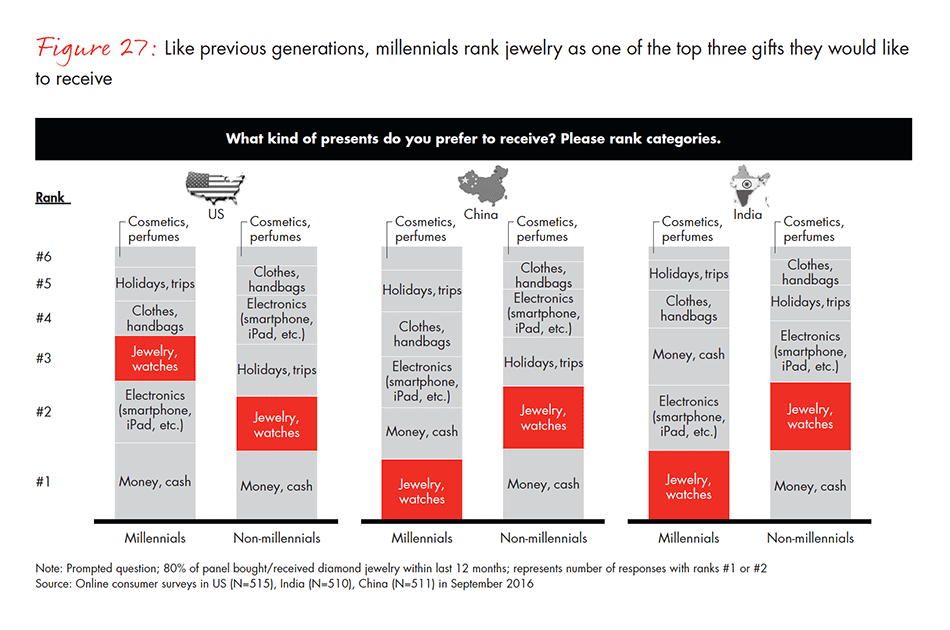
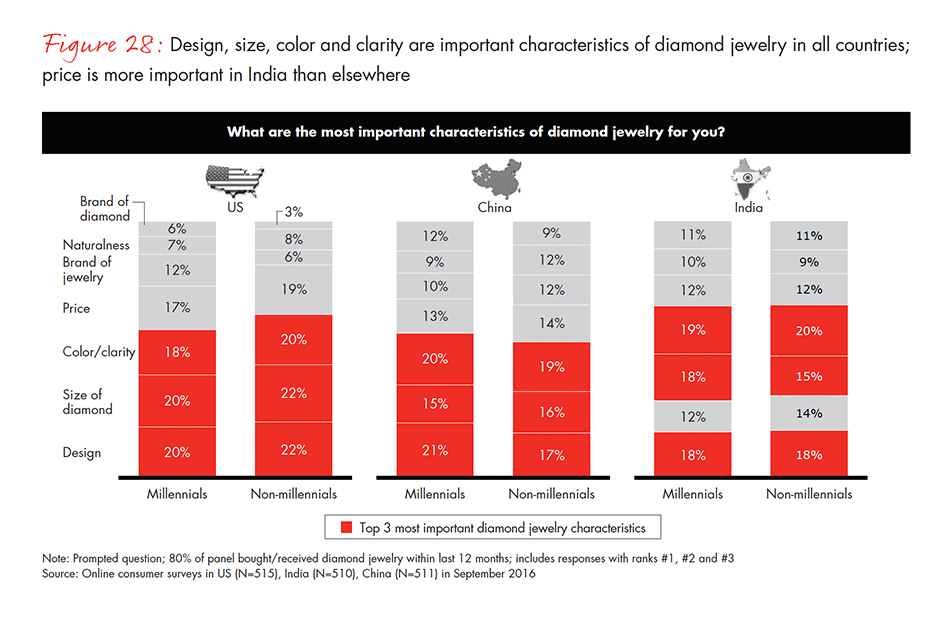
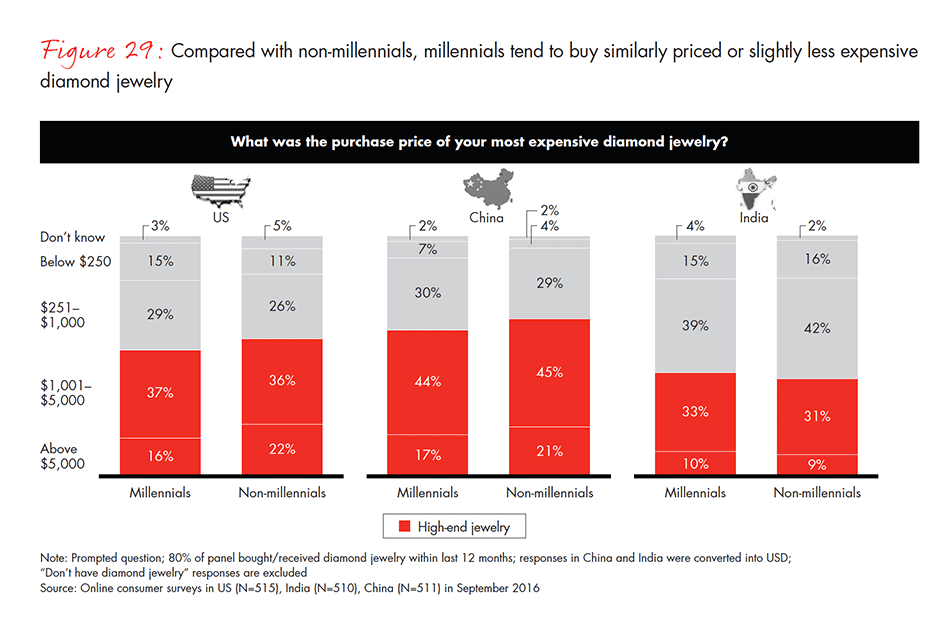
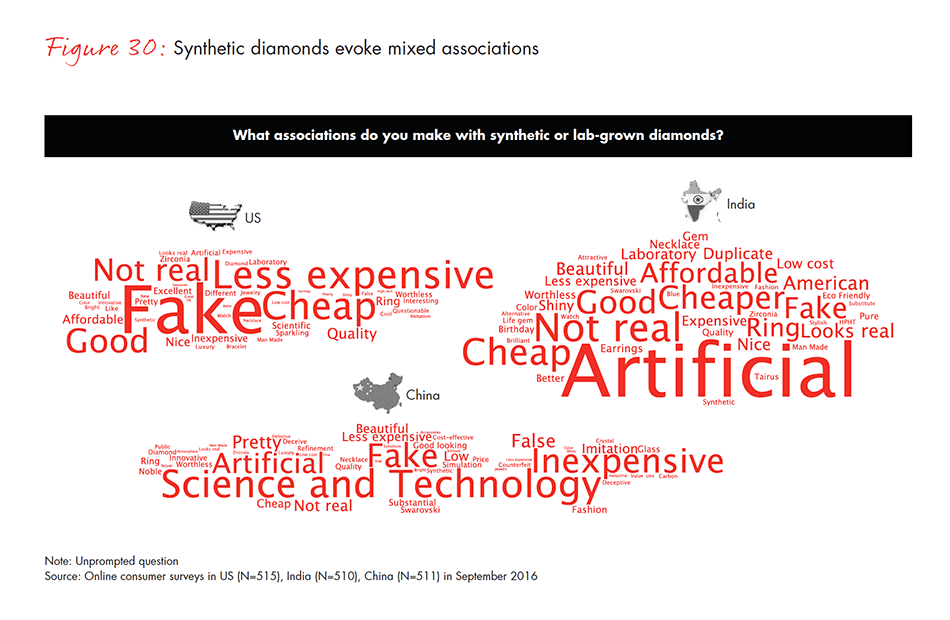
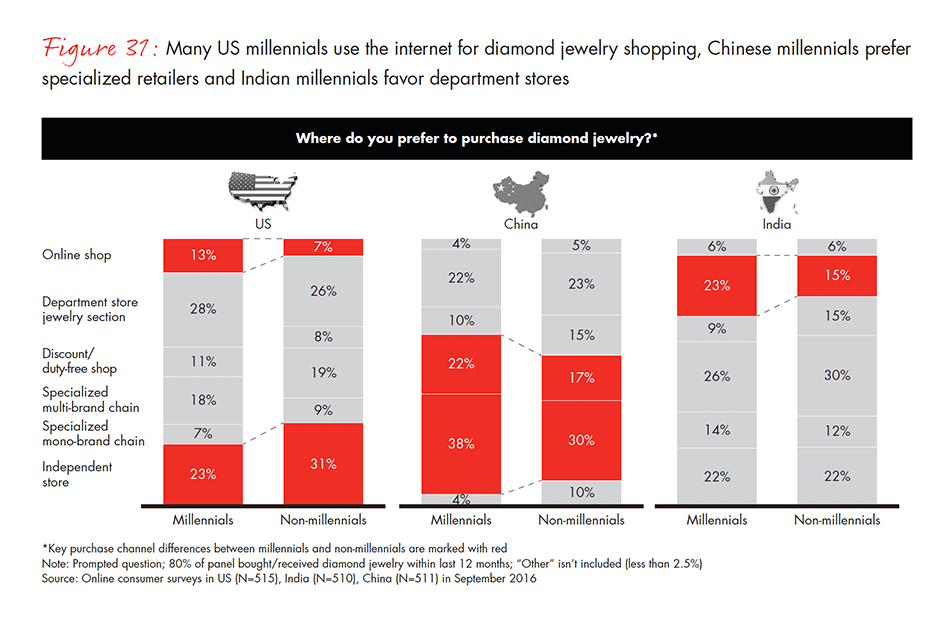
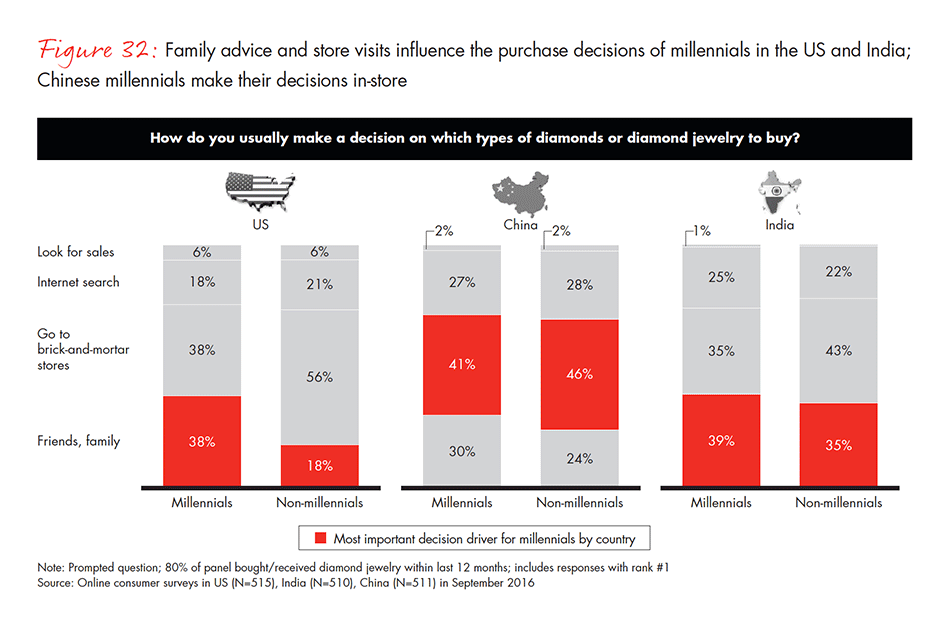
6. Key industry challenges
- Despite the continued importance of diamond jewelry to consumers and the fundamental attractiveness of the industry for investors, there are challenges that can be either a threat or an opportunity for the industry to emerge stronger in the long term.
- During the past few years, volatile diamond prices and stagnant diamond jewelry sales have continued to squeeze the profitability of midstream players. These companies must continue to redefine their business models to emphasize demand-driven inventory and production planning. Another constraint on the midstream is the reduction in financing available from traditional diamond banks. The financing squeeze will likely lead to a shakeout of less-efficient midstream companies. The surviving players, however, will have greater access to financing from large traders, and larger midstream companies can also tap traditional corporate financing mechanisms, provided their operations are demonstrably lean and transparent. All of these factors should continue to motivate the midstream to become leaner and more effective.
- A continued source of both concern and opportunity is the question of long-term demand for natural diamonds. As a new generation of consumers—the millennials—heads toward its prime spending years, the industry needs to find ways to effectively engage with them. Millennials are similar to previous generations of consumers in their attitudes toward diamond jewelry but differ in their decision-making and shopping patterns. To fully capture long-term demand from millennials, industry players need to invest in both category marketing and brand-building efforts and redefine the shopping experience. Efforts to sustain customer demand for natural diamonds can also soften the potential impact of a possible cyclical recession in the US within the next three to five years and the continuing GDP slowdown in China.
- Investment demand for diamonds could provide an additional source of demand growth. Investment can be facilitated either through the creation of trading platforms that offer price transparency or direct investment mechanisms that enable the physical accumulation of rough and polished diamonds. Various players continue to push in this direction, but their efforts have not yet produced meaningful results.
- Low profit margins in the cutting and polishing segment have heightened midstream players’ interest in synthetic diamonds, but synthetics have to date gained only limited acceptance among jewelry retailers and end consumers. To increase the attractiveness of natural diamonds, key industry players have formed the Diamond Producers Association, which focuses on marketing efforts to highlight the emotional appeal of natural stones. The industry is well equipped to detect and disclose counterfeit synthetics and continues to invest in R&D.
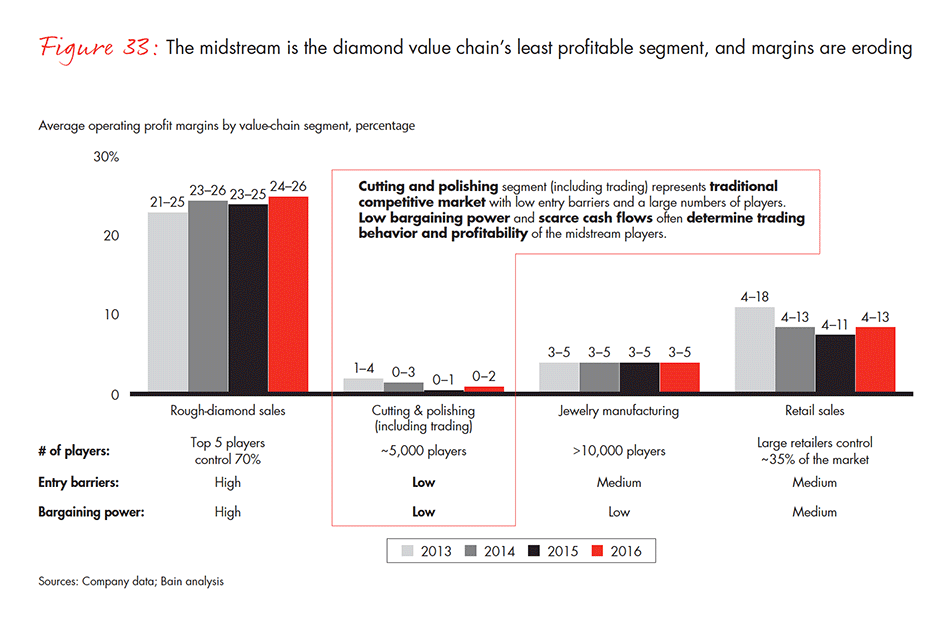
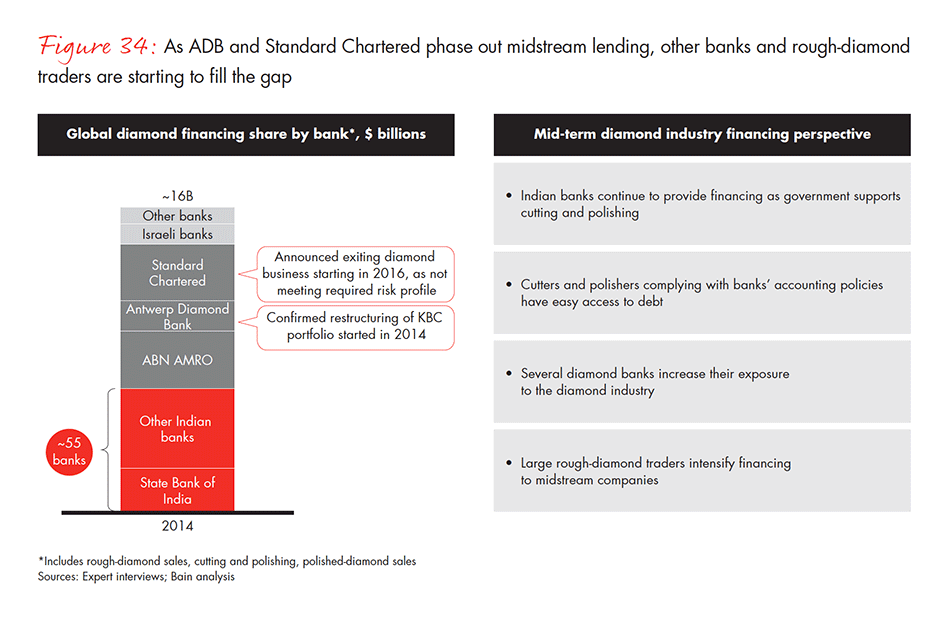
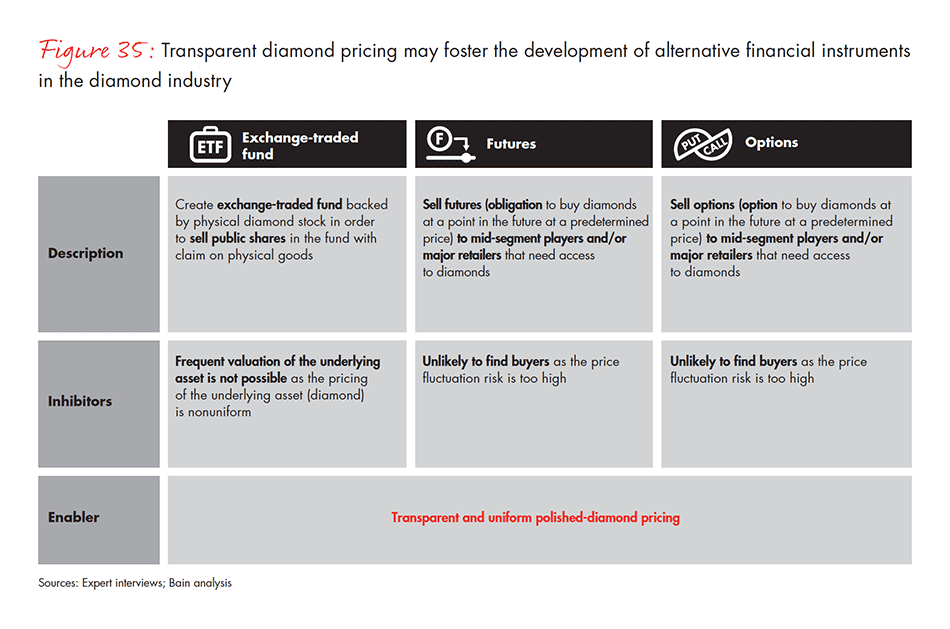
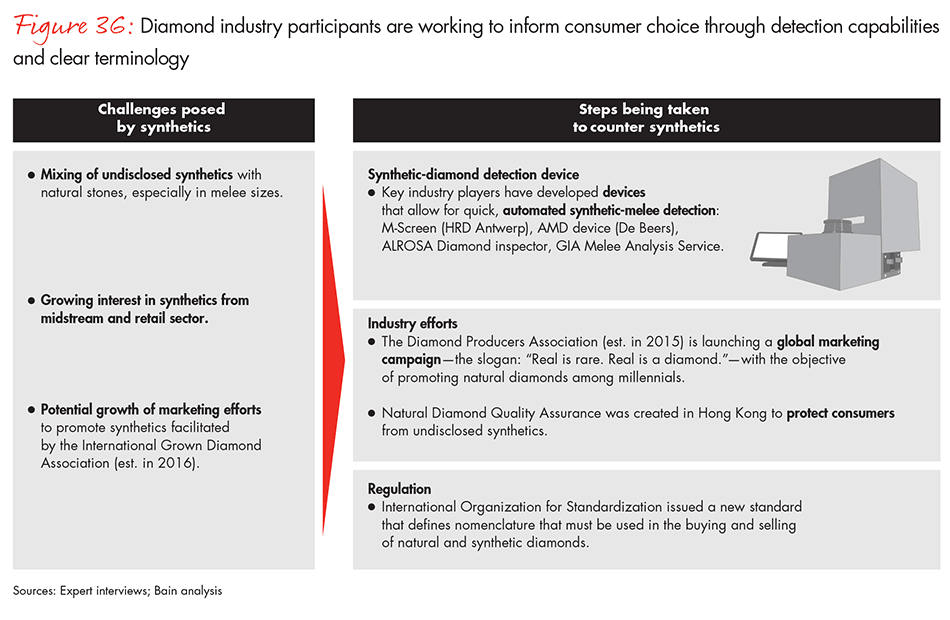
7. Updated supply and demand model
- Global rough-diamond demand through 2030 is projected to grow at an average annual rate of about 2% to 5%, and supply is projected to decline by 1% to 2% per year. This forecast reflects fundamental supply and demand factors rather than short-term fluctuations or unforeseeable long-term macroeconomic shifts. The lower range of the outlook for demand growth incorporates a possible partial substitution of demand for natural diamonds by synthetic diamonds. The short-term supply-demand balance will depend heavily on the behavior of major producers and market pipeline efficiency.
- China and the US are expected to remain the leading diamond jewelry markets and largely determine rough-diamond demand. India will likely become the third-largest market, ahead of Europe and Japan, by around 2020.
- Real disposable income growth of 1.5% to 2.5% per year in the US should stimulate diamond jewelry consumption, consistent with historical trends. Demand growth in the Chinese market is expected to resume a modest upward path in 2017, assuming positive underlying macroeconomic fundamentals. We expect a gradual return to positive growth trajectories beginning in 2018, with mid-single digit annual growth through 2030.
- We believe that India has a potential to be the fastest-growing diamond jewelry market in coming years on the strength of increasing urbanization, middle-class expansion and engagement ring penetration. Continued devaluation of the rupee, however, could negatively affect market growth rates in US dollar terms over the short to medium term.
- We have based our forecast of the rough-diamond supply on an analysis of existing mines, publicly announced plans and anticipated production at every expected new mine. We foresee that the global supply of rough diamonds will decline by an average of 1% to 2% per year from 2016 to 2030 because of the aging and depletion of existing mines. New supply from the Luaxe mine in Angola will be partly offset by likely delays in the start of operations at the Bunder mine in India and the shutdown of the Snap Lake mine in Canada.
- This forecast does not consider several factors that could disrupt the diamond supply-demand balance. In particular, the possibility of a cyclical recession in the US, uncertainties about the future of the EU following the Brexit referendum and slowing economic growth in China and India could erode demand for diamonds. Technical supply disruptions, the impact of commodity prices on major producing countries and potential new sources of supply could affect global rough-diamond production.
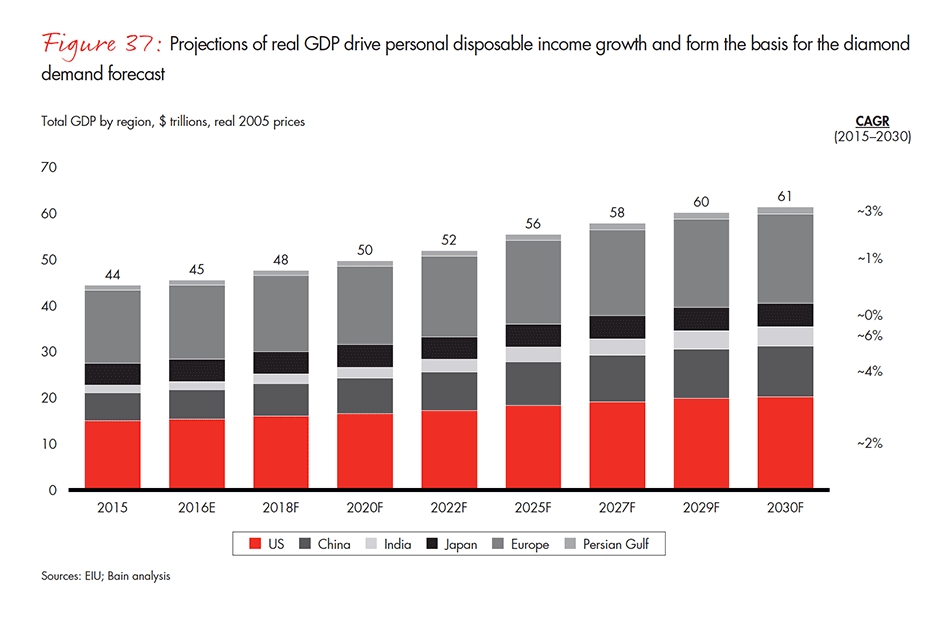
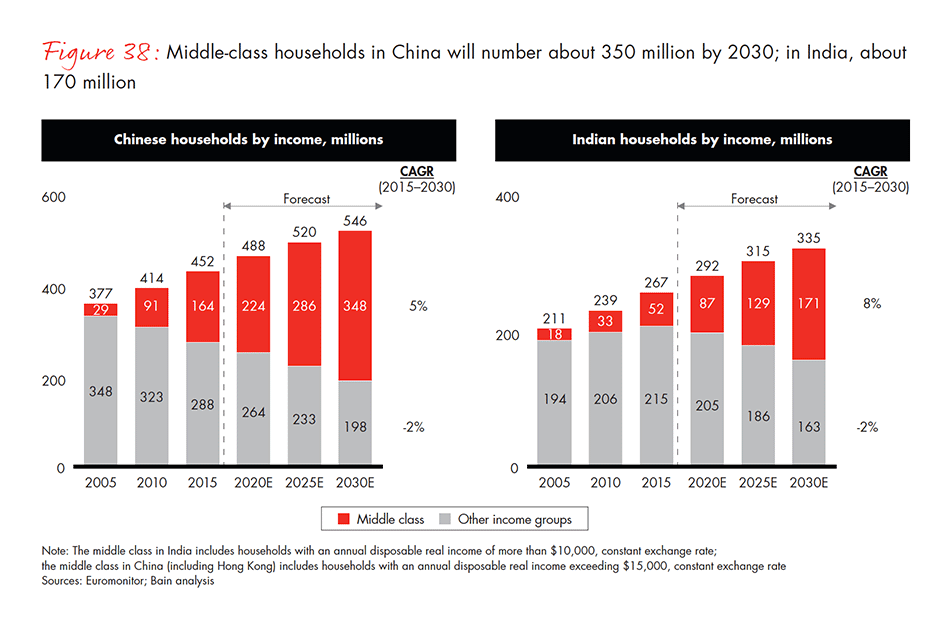
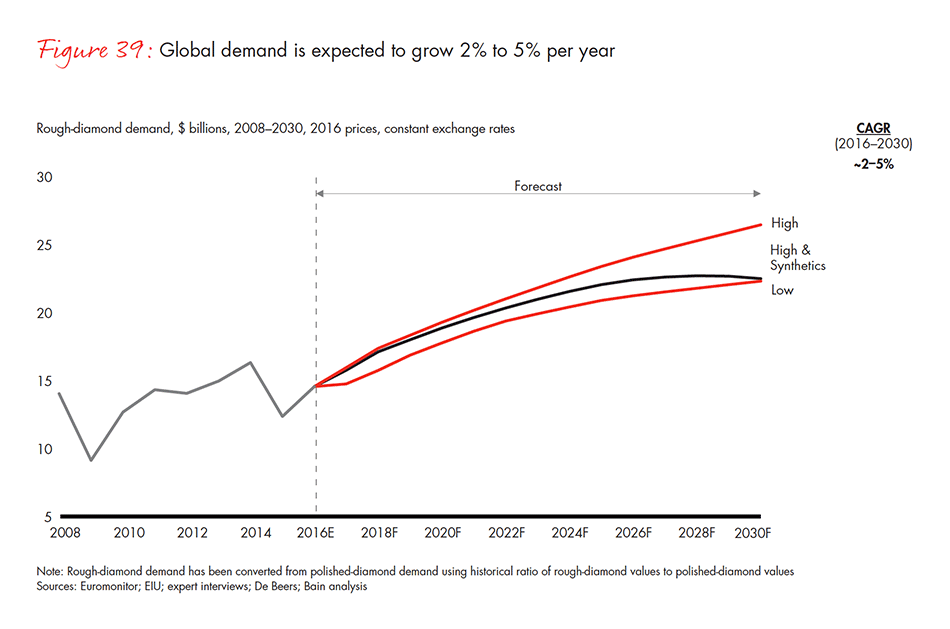
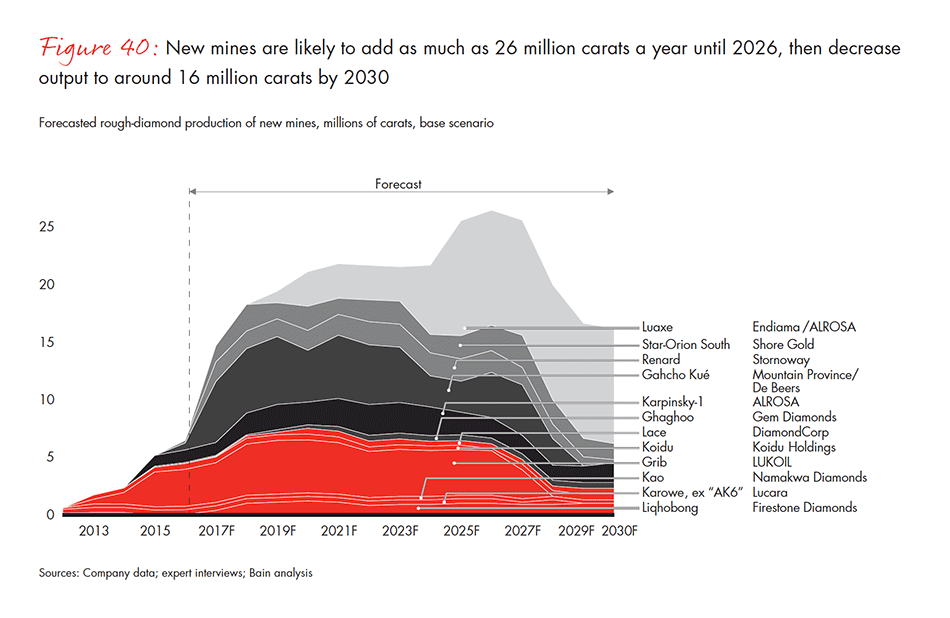
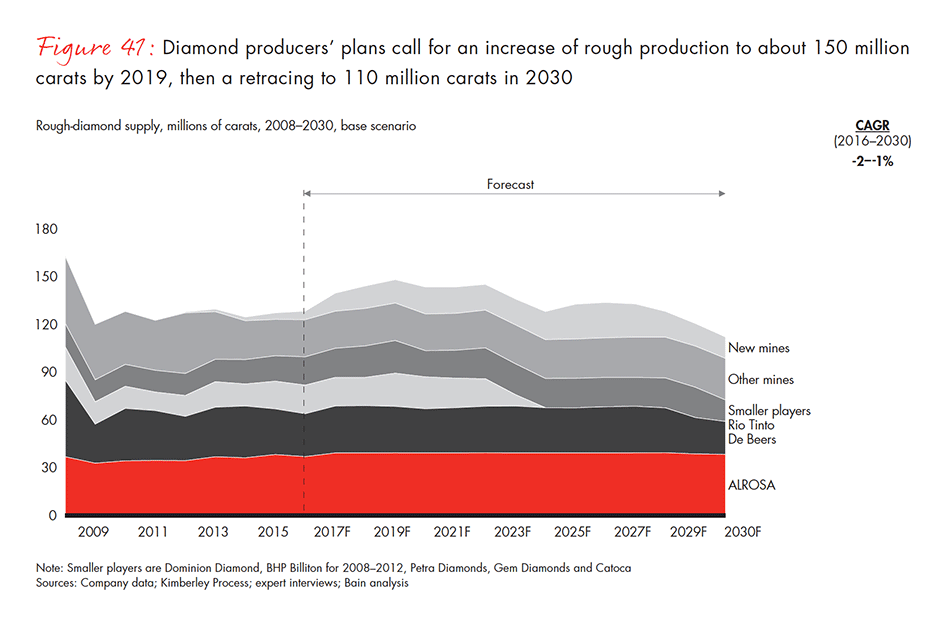
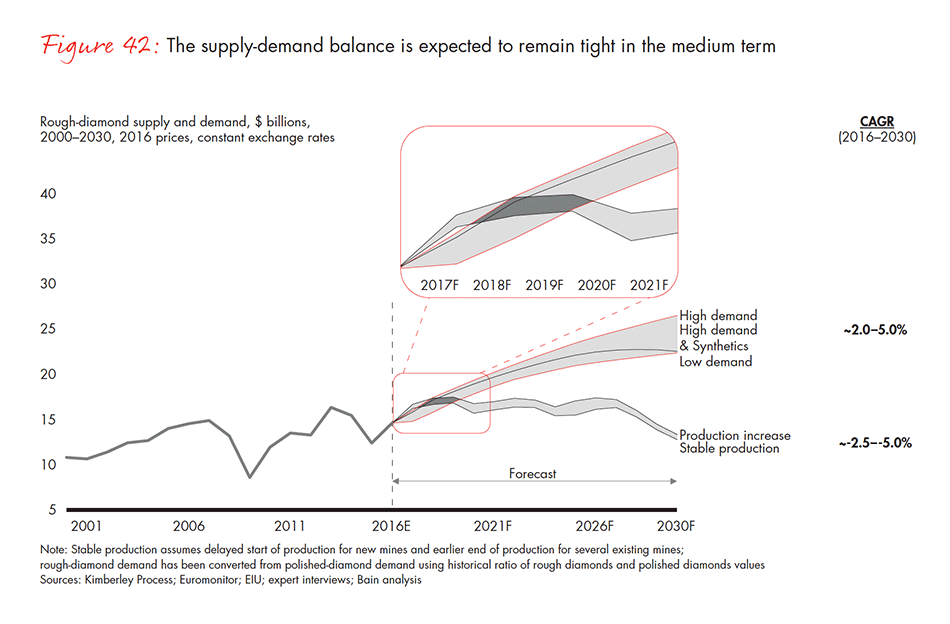
This report was prepared by Olya Linde, Partner from Bain & Company, and Aleksey Martynov, Principal from Bain & Company, together with Ari Epstein, Chief Executive Officer, AWDC, and Stephane Fischler, President, AWDC. The authors were supported by a global team, including Michael Gienger, Dmitry Lopyrev, Kirill Tsibizov, Fedor Zakharchenko, Thai Son Trinh, Anton Matalygin, Masha Shiroyan, and Bain’s Mining and Luxury Goods practices.









































